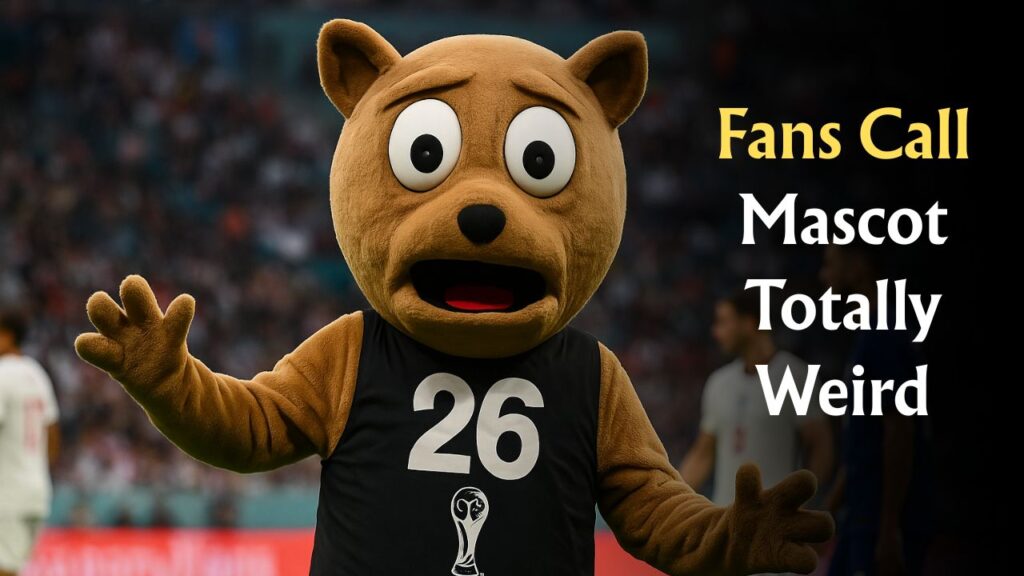The World Cup 2026 mascot has finally been unveiled, but it’s not quite what fans were expecting. Instead of sparking excitement, the character has triggered an online storm, with social media users calling it “weird,” “cursed,” and even “AI gone wrong.” The unique design, inspired by North American culture and digital creativity, has become a hot topic across football communities. While organizers aimed for innovation and diversity, the internet has turned the reveal into a meme fest — proving once again that the world of football mascots is never short of surprises or controversy.

World Cup 2026 Mascot Design and Concept
The official FIFA mascot design is a bold mix of tradition and technology. Shaped like a stylized character blending human and animal traits, it represents the three host nations — the United States, Canada, and Mexico. The design aims to celebrate unity and cultural diversity across borders. According to FIFA, the mascot’s “futuristic” appearance was generated using digital design tools to reflect modern football’s innovation. However, many fans feel the result leans too heavily on AI aesthetics, making it look unnatural and emotionless — unlike beloved classics such as Zakumi or Fuleco.
Social Media Reactions from Fans
Within hours of its reveal, the World Cup mascot became the subject of memes and jokes online. Football fans flooded platforms like X (Twitter), Instagram, and Reddit with their hilarious takes. Some compared the design to a “glitchy video game character,” while others suggested it looked like something “straight out of a 3D printer meltdown.” Despite the criticism, some users appreciated FIFA’s attempt to be modern and inclusive. Still, the overall mood remains divided — a reminder that even in 2026, football culture thrives on spirited debates and passionate opinions.
 World Cup 2026 Opening Ceremony: Date, Venue, Performers, and What Fans Can Expect This Time
World Cup 2026 Opening Ceremony: Date, Venue, Performers, and What Fans Can Expect This Time
Symbolism and Message Behind the Mascot
FIFA officials defended the design, explaining that the mascot embodies the theme of “We Are 26,” representing unity, creativity, and inclusivity. Its unusual features are said to symbolize global connection and cultural fusion across North America. The mascot will appear in promotional campaigns, merchandise, and official fan events leading up to the 2026 World Cup. The organization believes it will grow on fans over time, much like earlier mascots that were initially mocked but later embraced — showing that public opinion can evolve once the event spirit takes over.
Full List of Mascot Details and Launch Highlights
Here’s a quick look at the key facts and details surrounding the launch of the controversial mascot. From design origins to fan responses, this table sums up everything football enthusiasts need to know about the new face of the World Cup.
| Feature | Details |
|---|---|
| Event | FIFA World Cup 2026 |
| Host Countries | United States, Canada, Mexico |
| Design Type | AI-inspired digital character |
| Theme | We Are 26 – Unity & Creativity |
| Public Reaction | Mixed – described as “weird” and “AI gone wrong” |
| Launch Date | October 2025 |
| Purpose | Official mascot for global branding and fan engagement |
FAQ 1: Who designed the 2026 World Cup mascot?
The mascot was created by FIFA’s digital design team in collaboration with North American artists.
FAQ 2: Why are fans calling it “AI gone wrong”?
Because of its robotic and digitally generated look, fans think it lacks warmth and personality.
FAQ 3: Which countries will host the 2026 World Cup?
The tournament will be co-hosted by the United States, Canada, and Mexico.
FAQ 4: What does the mascot symbolize?
It represents unity, creativity, and the shared spirit of North America under the theme “We Are 26.”




